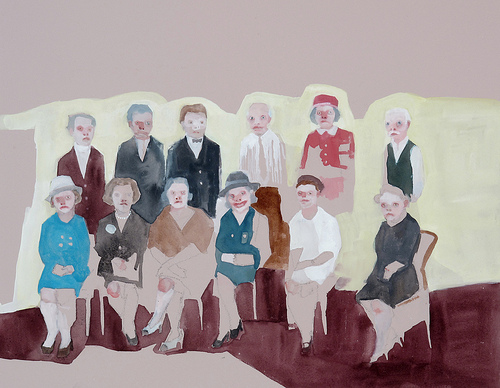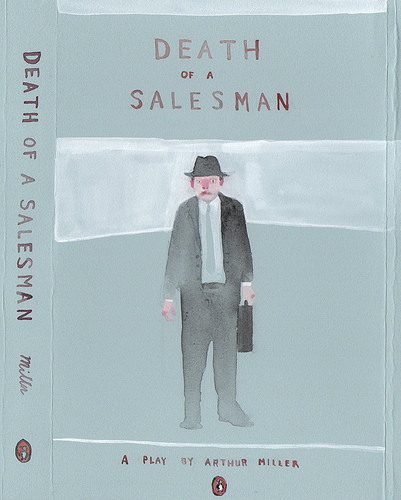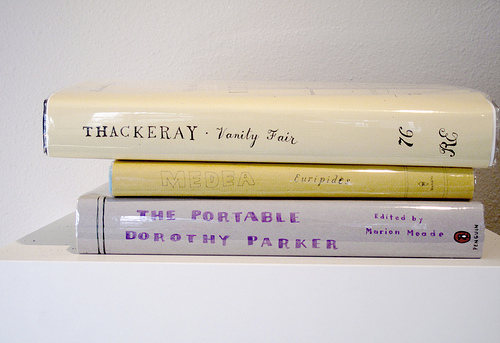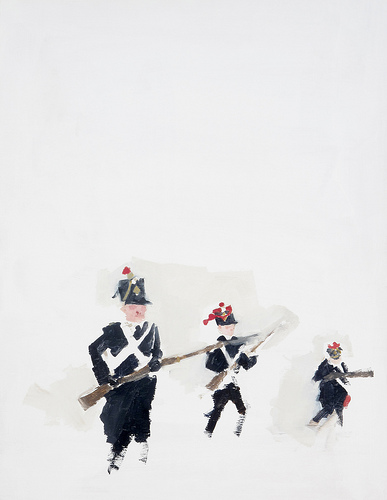San Francisco-based artist Jennie Ottinger has a knack for editing a situation down to its most poignant essentials. In her bountiful solo exhibition Due By (through January 8, 2011) at Johansson Project in Oakland, she continues to apply this talent to painting, both in gouache and oil (in addition to pen-and-ink drawings), and also extends into literature and book art. She's successful throughout.

Memento Mori by Jennie Ottinger
courtesy Johansson Project
The overarching subject of Due By is literary classics; the title of the show points to the time-pressure anxiety many of us feel about getting around to reading these historically important books; we really need to get on that before it's too late.

Death of a Salesman (cover) by Jennie Ottinger
courtesy Johansson Project
The paintings are imagined illustrations for the stories. The book art, which is all made by altering real books, comes in two flavors: stacks of books for which Ottinger has created the covers and singular altered books for which the artist has both made the cover and replaced the many pages with summaries of the works that she has meticulously penned herself.

Class Reunion by Jennie Ottinger
courtesy Johansson Project
"I love reading," states Ottinger when asked about her motivation for this show, "and there are so many books I want to read or feel like I should read that it is overwhelming. With more appealing and acclaimed books coming out every year, it is almost panic inducing. The books are also a stand-in for other activities commonly found on 'before you die' lists--movies to see, cities to visit, beaches to lounge on, golf courses to golf on. Also I was thinking of how important efficiency has become perhaps because everyone feels the urgency to do so many things, and I wanted an answer to the e-reader. I made the books look like regular books so they seem like old fashioned, hard cover novels, but the summaries are written from other summaries, so they are extra boiled down to their essence and therefore more quickly and easily digested."

text for Moby Dick by Jennie Ottinger
courtesy Johansson Project
These summaries are not only easy to process, they're witty, accurate, and hip. For Anna Karenina, Ottinger begins telling the story thus: "Dolly Oblonskaya caught her husband, Stiva, boinking their kids' former governess just like Jude Law. Stiva feels bad a little but doesn't really understand the fuss. His sister, Anna Karenina, comes over to help them work it out. We will soon see evidence of her extraordinary relationship skills." Moby Dick begins this way: "This book is more tedious than the war parts of War and Peace but the character names are so much better!" The telling of the story starts with, "The year is 1840 and this Ishmael character, who sounds like a barrel of monkeys, goes to Nantucket to begin a whaling voyage. Before setting sail, he visits a local chapel and is moved by the memorial plaques for lost sailors. He becomes nervous about the dangers of whaling. To add insult to injury, the sermon is about Jonah and the whale. Now I've personally been to Nantucket and Mystic Seaport so I know a thing or two about whaling, and it can indeed be quite dangerous because whales are nothing if not very very big."

"If You Don't Have Anything Nice to Say Come Sit By Me" by Jennie Ottinger
courtesy Johansson Project
The stacks share a humorous tone and highlight shared themes, however tongue in cheek. "The One that Got Away" features the novels Moby Dick, The House of Mirth, The Age of Innocence, and Rabbit, Run; in "If You Don't Have Anything Nice to Say Come Sit By Me" we find Vanity Fair, The Portable Dorothy Parker, and Euripides.

Soldiers (Scene from War and Peace) by Jennie Ottinger
courtesy Johansson Project
The paintings and drawings capture, as says Ottinger, non-action scenes from the novels. "I think the background or set-up scenes," she notes, "are usually more interesting in a story." This is fitting with Ottinger's style, which itself is subtle but significant. They're the quiet ones that are the impetus for what ends up getting the spotlight, so pay attention. Aesthetically these works are rough and sketchy. The figures and objects almost appear to be fading away, decomposing before your eyes. "I enjoy the push and pull between the background and foreground," Ottinger says, "so that the subjects seem to be deconstructing." There is more than a hint at morality. And as such, the work instills a compulsion to study them close; take note of what's here before it's gone. The sketchiness also allows for some viewer imagination to fill in the well-timed negative space.
Ottinger delivers a seriously fun cultural romp with just the right dose of neurosis-inducing discomfort. This is a show that lingers long after you've departed from the ghostly images and time-honored texts.